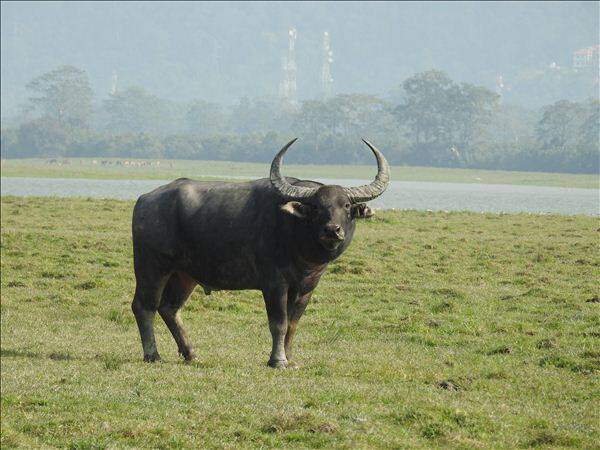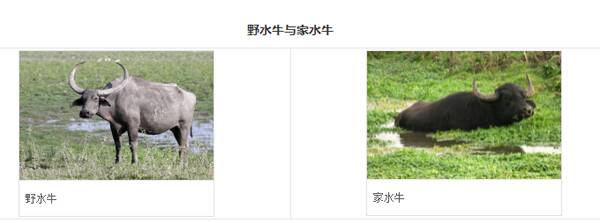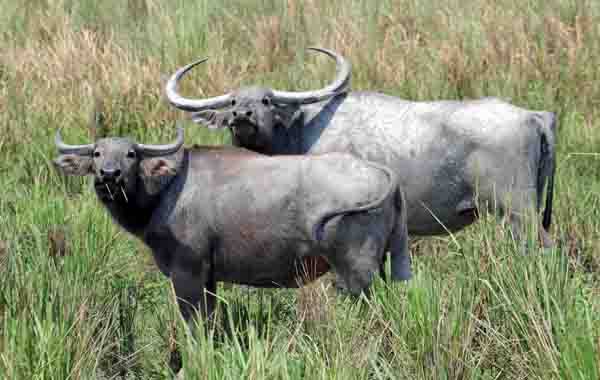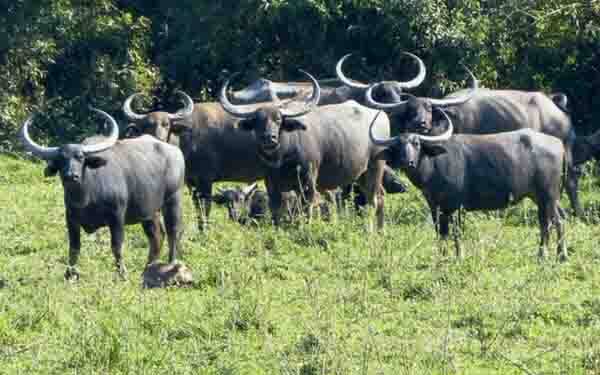Bubalus arnee
IUCN
LCBasic Information
Scientific classification
- name:Bubalus arnee
- Scientific Name:Bubalus arnee,Asian wild buffalo, Asian water buffalo, Indian wild buffalo
- Outline:Ungulata
- Family:Artiodactyla Bovidae Buffalo
Vital signs
- length:2.4-2.8m
- Weight:800-1200kg
- lifetime:About 15 years
Feature
Of all the bison species, the wild buffalo has the largest horns, which can reach up to 2 meters in size.
Distribution and Habitat
Distributed in Bhutan, Cambodia, India, Myanmar, Nepal, Thailand.
Extinct: Bangladesh, Indonesia, Laos, Malaysia; Sri Lanka and Vietnam.
Usually active between sea level and 1500 meters above sea level, the wild buffalo is very dependent on water supply, and its preferred habitat historically has been low-lying alluvial grasslands, including oxbow lakes and similar ponds formed by river channel changes and their surroundings, small sand islands in river banks and braided river systems, riparian forests and woodlands. It mainly lives in grasslands, alluvial plains and swamps, although it can use woodlands for shelter. It is usually found near water bodies, such as open rivers, swamps and seasonal lakes, and often spends most of its time in muddy water.
Appearance
The head and body length of the wild buffalo is 240-280 cm, the shoulder height is 160-190 cm, and the tail length is 60-85 cm; the weight is 800-1200 kg. The forehead is narrow and long. The ear shell is short and small, shaped like a large trumpet. The body is large, the chest is bulging, the legs are short and the hooves are large. Males are often much larger than females, with a solid texture and resistance to soaking. The lower legs are pale, but this may be difficult to distinguish because buffalo often wallow in the mud. One or two white crescents usually appear on the throat or upper chest, and there may also be faint light spots around the eyes, on both sides of the nose and on the mouth. The ears tend to droop downward. Both sexes are gray to black, usually darker on the head and lighter on the body. Mature males are often very dark. The hair on the midline of the back is forward, and the back slopes downward and backward. The knee joints and fetlocks are flexible, and the ha
Details
Wild buffalo (scientific name: Bubalus arnee) is called Wild Water Buffalo, Asian Buffalo, Asiatic Buffalo, Indian Buffalo, Indian Water Buffalo, Water Buffalo, Wild Asian Buffalo in English, Buffle d'Eau, Buffle de l'Inde in French, Búfalo arni in Spanish, Arni, Asiatischer Wasserbüffel in German, and has 5 subspecies.

The Asian wild buffalo "Bubalus arnee Kerr" (=Bubalus bubalis Linn. Linnaeus did not distinguish between domestic buffaloes when naming) is one of the largest members of the Bovidae family. They are also the ancestors of all local domestic buffalo breeds. Although the exact time and place of its domestication is uncertain, it has undoubtedly existed in India and China for at least 5,000 years. Tamed and possibly domesticated buffalo appear on seals from the Indus Valley (Mohenjo-daro) and Mesopotamian civilizations from the mid-3rd millennium BC. According to McIntosh (2007), "buffalo appear on seals from the Indus Valley and appear wild".
Of all the wild cattle species, the wild buffalo has the largest horns, which can reach up to 2 meters in range (i.e. the distance between the curved outer edges of the two horns). Both sexes have these huge horns, which are the easiest criterion to distinguish this species from the domestic buffalo. The domestic buffalo (Bubalus bubalis) is generally smaller than the wild buffalo and varies in color: individuals may be dark gray or black, brown, white, or piebald. The horns of domestic buffalo are variable, they usually have a tight curl, if crescent-shaped, rarely reaching the size of wild buffalo horns.

Little is known about the behavior of wild buffalo. They gather in small groups, usually with a male, and females and calves in groups of 10-20. In rare cases, herds can have up to 100 individuals. Young males usually live in small bachelor groups (6-8 animals), while older males tend to be solitary.
Wild buffalo may be active both during the day and at night, but peak feeding activity usually occurs in the afternoon and evening. Daytime is usually spent in the forest or near ponds, which provide relief from the midday heat. They are very fond of water, and wallowing in the mud is a regular activity, especially in summer, to cool down and prevent insect bites. The horns are sometimes used as shovels to increase mud cover. This species is dependent on water, and the family range expands and contracts based on its seasonal availability. Historical records indicate that long-distance seasonal migrations (covering distances of more than 200 kilometers) have occurred, although no remnant populations engage in such migrations. Observations in Nepal indicate that herds occupy stable ranges. Wild buffaloes are seen in a single file, with an adult female in front, calves in the middle, and the rest of the adults behind. Wild buffalo are very protective of their young, and when threatened, mothers will form a protective line in front of their calves. If the threat persists, they will flee to tall grass or forests, and will not (although they are strong swimmers) enter the water.

Wild buffalo mainly eat grass, but also some fruits, leaves, bark, saplings, and crops.
There are often conflicting reports about the breeding season of wild buffalo, which either have a distinct breeding season, a five-month estrus, or breed year-round; this may be due in part to regional variation. Females typically give birth to one offspring every two years. At birth, calves are light brown. They begin to darken at around six months; females reach their mature adult color at two or three years of age, while males do not fully darken until after four years of age. Females typically remain in the herd in which they were born, while males disperse in their third year.

There are only about 4,000 wild Asian water buffalo in the world, and they are seriously genetically contaminated by domestic buffalo. All wild subspecies are endangered and mostly live in protected areas. In addition to the threats of hunting and habitat loss, perhaps the greater threat to the species is the loss of genetic traits from hybridization with domestic buffalo.
Wild water buffalo are legally protected in Bhutan, India, Nepal and Thailand. The Cambodian population was a major factor in the decision to further protect the area (designated as Mondulkiri Protected Forest) and was also an important factor in the decision to establish the Cambodian Forestry Department and WWF's Srepuk Wilderness Area Project. Most known populations are within protected areas. In Myanmar, it retains a near-natural, true lowland floodplain in the Hukaung Valley area, a protected area system that initially almost completely excluded floodplain grasslands. Consideration is being given to including some areas, which would benefit the species. However, the outcome is uncertain. Most of the remaining populations still require substantial protection from hunting (particularly in Thailand, Cambodia and Myanmar, if it still exists), but the greater threat in South Asia may be to prevent contact with other domestic cattle, especially domestic water buffalo. There is an urgent need to assess the integrity of wild buffalo populations using representative habitats of wildlife, including those generally regarded as truly wild and those living as feral animals in their native ranges, even outside occasional animal husbandry, for a long time, in order to identify priority populations for conservation. This should include an assessment of the relationships between such populations in the context of apparent lineages, especially those close to wild populations. This approach should use multiple genetic markers in addition to assessing morphological traits. Surveys of the satay region from Myanmar to Vietnam are needed to investigate the status of wildlife populations. In India, a new conservation action plan has been developed that seeks to restore wild buffalo in central India. At the local level, the governments of Chhattisgarh and Maharashtra, which have the last remnants of wild buffalo populations in central India, have both committed to protecting the species, with the former making it the state animal.
Listed in the IUCN Red List of Threatened Species in 2016 ver3.1 - Endangered (EN).
Listed in Appendix III of the Convention on International Trade in Endangered Species of Wild Fauna and Flora (CITES).
Protect wild animals and eliminate game.
Maintaining ecological balance is everyone's responsibility!








